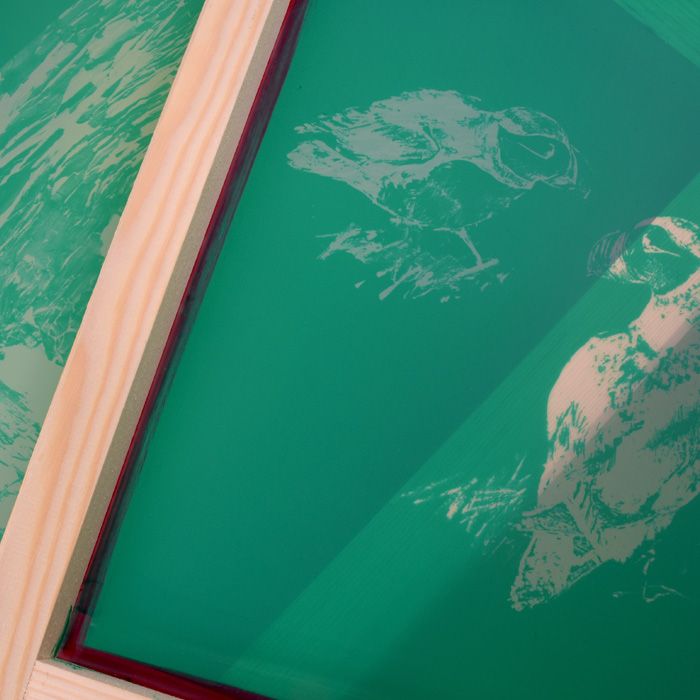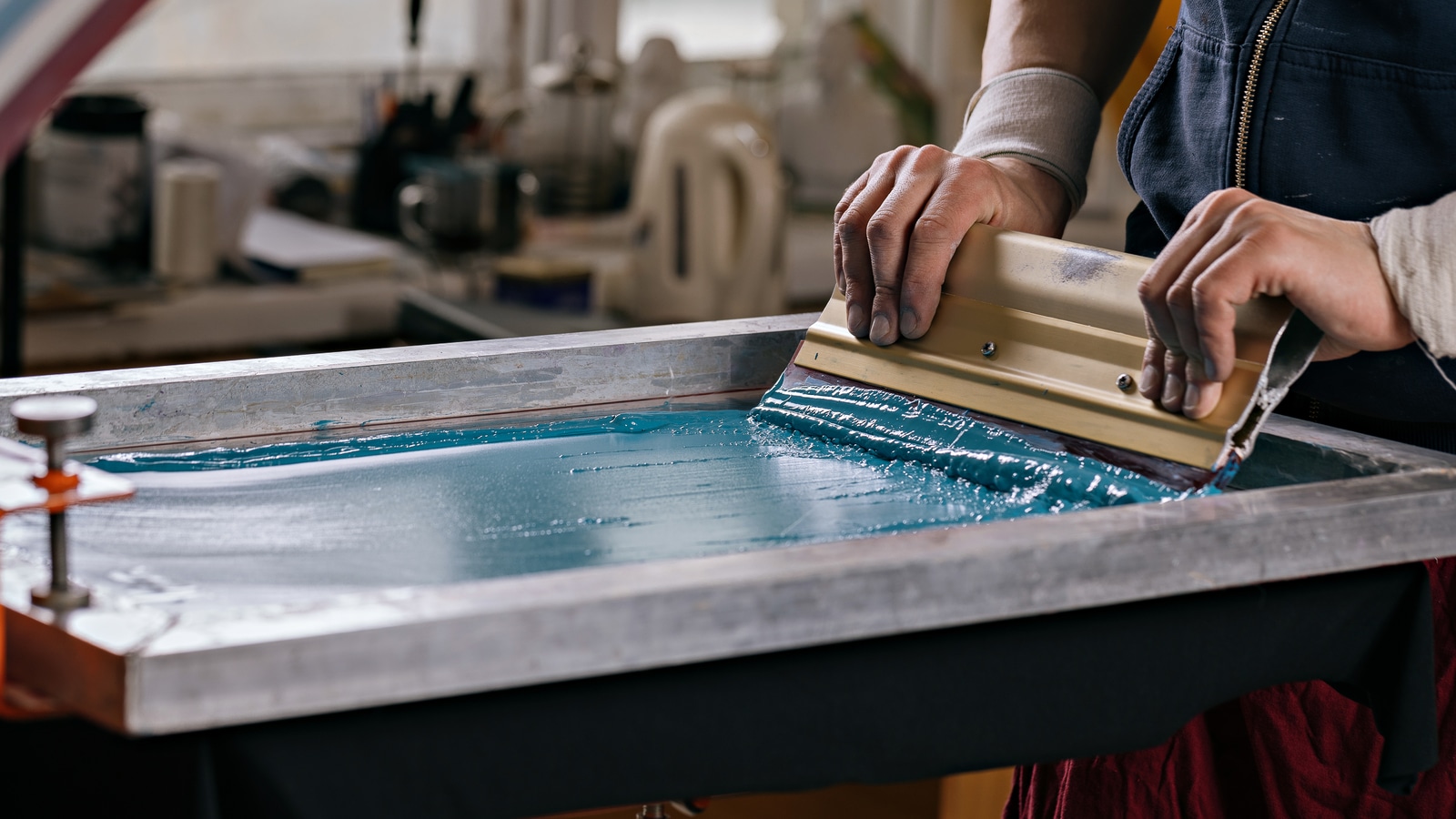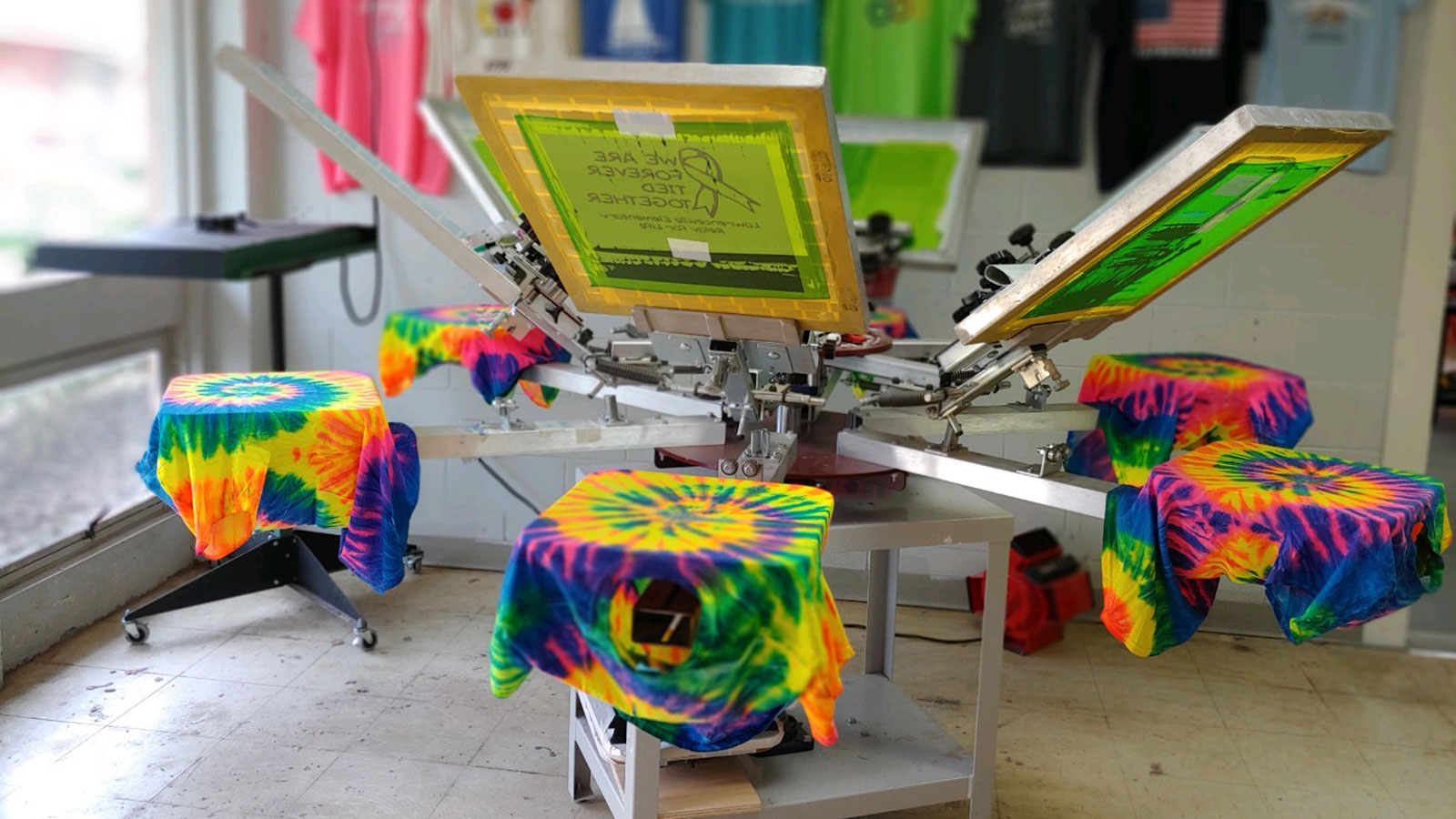Custom Screen Printing for Unique Promotional Merchandise
Wiki Article
Screen Printing Uncovered: Whatever You Need to Learn About Tee and Garment Printing Techniques
If you have actually ever questioned just how those lively designs finish up on your favorite tee shirts, you remain in the appropriate location. Display printing is an interesting technique that incorporates art with technique, using unlimited opportunities for imagination. Comprehending the principles, from equipment to ink choices, can greatly impact your results. Prepared to explore the important elements that make display printing an art form? Let's uncover the details that can elevate your jobs.
The Fundamentals of Display Printing: How It Functions
When you dive into display printing, you'll uncover it's both a scientific research and an art. At its core, display printing includes producing a pattern, or screen, that permits ink to pass with just in specific areas.Next, you'll mix your inks and prepare your printing surface. Setting the display over the fabric, then make use of a squeegee to push ink via the screen onto the garment. This procedure requires precision, as you desire clear, lively prints. After printing, you'll cure the ink with heat, ensuring it adheres to the fabric and lasts through cleans. Each step is vital, and understanding them will certainly raise your display printing skills, transforming simple garments into distinct, meaningful pieces.
Kinds Of Display Printing Techniques
As soon as you comprehend the essentials of display printing, it's time to explore the various techniques that can elevate your styles. One prominent technique is standard screen printing, where ink is pressed through a stenciled screen. This strategy is wonderful for strong, dynamic colors. Then there's water-based ink printing, which uses a softer feeling and is green, but it calls for a various strategy to healing.If you're going for fine information, take into consideration discharge printing. This strategy eliminates dye from the fabric, leaving a soft, vintage look. One more choice is plastisol printing, understood for its sturdiness and dazzling colors, making it a preferred for lots of brand names. Lastly, trying out halftone printing to produce slope effects and elaborate designs. Each method has its special beauty, so do not be reluctant to attempt them bent on find what suits your style best!
Necessary Equipment for Display Printing
To attain spectacular cause screen printing, having the appropriate equipment is basic. First, you'll require a durable display printing frame, which holds the mesh that moves your style onto the garment. Next, buy premium squeegees; these are crucial for applying ink evenly across the display. You'll additionally call for a good exposure system to produce your displays, as well as a washout cubicle for cleaning them after usage. A reputable heat source, like a conveyor dryer or warmth press, is crucial for curing your prints to ensure durability. Do not neglect a proper work space, equipped with tables and storage for your products. Finally, safety equipment, such as handwear covers and masks, will maintain you risk-free from chemicals and inks. With the right devices, you'll be well on your means to creating professional-quality prints.Choosing the Right Inks and Materials
When picking inks and materials for display printing, you require to take into account the sort of ink that works best for your job. Think about textile compatibility to ensure your styles look last and terrific long. Also, discover environmentally friendly ink choices to make your printing process more sustainable.Kinds Of Display Inks
Selecting the best screen ink is essential for achieving lively, long lasting prints that fulfill your project's requirements. There are numerous kinds of screen inks to take a look at. Plastisol ink is preferred for its flexibility and ease of usage, offering superb shade opacity on dark fabrics. Water-based ink, on the other hand, offers a softer feeling and is eco-friendly, making it optimal for those aiming to decrease their ecological impact. Discharge inks get rid of dye from the fabric, leading to a soft, classic look yet require certain handling. Finally, specialty inks, such as glow-in-the-dark or metallic, can add unique impacts to your designs. Evaluate your project demands and select the ink that lines up ideal with your wanted end result.
Material Compatibility Factors To Consider
Recognizing fabric compatibility is vital for achieving top notch screen prints, particularly considering that various products respond distinctly to numerous inks. When picking inks, consider the textile type-- cotton, polyester, or blends. For cotton, water-based inks function well, providing gentleness and breathability. Polyester, on the various other hand, frequently calls for plastisol inks for better attachment and vibrant colors. If you're printing on blends, you could require to use a combination of both kinds. Always evaluate your inks on example material to assure they stick appropriately and maintain shade integrity. Additionally, bear in mind that material weight and texture can influence the final outcome, so picking the best ink and product combo is essential for your job's success.Eco-Friendly Ink Options
Green inks are becoming a preferred option for screen printers that want to lessen their environmental effect while maintaining top quality. When selecting inks, think about water-based inks, which are much less dangerous and simpler to clean up contrasted to traditional solvents.Furthermore, seek inks made from renewable energies, such as soy or vegetable-based alternatives. By selecting the ideal inks and materials, you'll not only create stunning layouts yet additionally add to a much more sustainable printing process. Make the switch, and your prints will reflect your dedication to the setting!
Preparing Your Style for Screen Printing

Submit Style Requirements
To assure your style looks vivid and sharp on material, you'll need to pay close attention to submit format needs for display printing. Make certain your style has a transparent background to avoid undesirable white edges on your prints. Keep shade modes in mind; CMYK is basic for screen printing, so convert your RGB makes appropriately.Color Splitting Up Methods
Color splitting up is a vital action in preparing your style for display printing, and mastering it can considerably improve your print top quality. You'll need to break your style into private shades, as each color needs a separate screen during printing. Beginning by recognizing all the colors in your layout and create layers for each one. You can make use of software like Adobe Photoshop or Illustrator to isolate and separate shades efficiently. Be certain to conserve each layer as a separate documents, normally in a layout like TIFF or PSD. This precision not just ensures precise color representation but also simplifies the printing process. By taking notice of color splitting up, you'll attain specialist and lively outcomes in your screen-printed garments.Resolution and Dimension
Achieving the ideal cause screen printing starts with guaranteeing your layout has the right resolution and dimension. Preferably, your artwork ought to be at least 300 DPI (dots per inch) for sharp, clear prints. If you make use of lower resolution, your end product might look less than professional and pixelated.When it involves size, think about the measurements of your print location. Style your artwork to match the last print dimension, preferably creating it in the actual measurements you'll be printing. In this manner, you'll prevent any type of unanticipated scaling problems.
Constantly check your layout in both vector and raster styles. Vector graphics can be scaled without losing high quality, making them perfect for display printing. Preparing correctly will guarantee your design looks remarkable on every garment!
Step-by-Step Screen Printing Process
Screen printing is a dynamic process that enables you to create vibrant layouts on different surfaces. To get started, you'll need a display, solution, and your chosen ink. Prepare your display by cleansing it completely. Next, apply the solution equally and let it dry in a dark area. When completely dry, subject your display to light with your layout positioned on it, which will solidify the solution where the light hits, producing a stencil - screen printing kit.After cleaning out the unexposed emulsion, your screen prepares. Set it up on your printing surface area and align your garment beneath it. Pour ink onto the display and utilize a squeegee to press the ink through the stencil onto the textile. Raise the display meticulously and allow the print dry. Finally, heal the ink utilizing warmth to assure resilience. That's it! You have actually efficiently screen published your design.
Tips for Effective Screen Printing Projects
While you're diving into your screen printing tasks, remember that prep work is key to success. Beginning by collecting all your products-- inks, screens, garments, and squeegees. A tidy office assists stop undesirable mistakes, so clean up prior to you start.Next, confirm your art work is high-resolution and correctly sized for your garment. Test your screen for proper direct exposure and clean it completely to avoid smudges. When blending your inks, adhere to the maker's standards to achieve the right uniformity.
Throughout printing, apply even stress with your squeegee for constant outcomes. Do not rush; take your time to validate each print meets your criteria. After printing, let your garments dry totally before taking care of or packaging them.
Last but not least, always maintain an example of your help future referral. This method, you can assess your progression and boost your techniques with time. Delighted printing!

Frequently Asked Questions
How much time Does It Require To Set up a Display Printing Job?
Establishing a display printing work normally takes about 30 mins to an hour. You'll prepare the displays, mix inks, and adjust the press. The moment differs based on intricacy and experience, so stay organized!Can I Print on Different Fabric Keys In Using the Very Same Method?
Yes, you can print on different material types using the very same strategy, yet you'll need to readjust your setups and inks. Some textiles soak up ink differently, so experimenting assurances the very best outcomes for each material.What Prevail Errors to Prevent in Display Printing?
When display printing, stay clear of usual mistakes like using the incorrect ink, neglecting appropriate direct exposure times, or missing pre-press checks. Constantly check your configuration and maintain clean screens to ensure high quality outcomes each time.Exactly How Can I Properly Tidy and Maintain My Screen Printing Tools?
To appropriately clean and keep your display printing devices, you should consistently wash displays with suitable solvents, examine mops for wear, and assure all tools are saved dust-free and completely dry. Uniformity protects against pricey repairs and improves efficiency.Is Screen Printing Eco-friendly Contrasted to Various Other Approaches?
Display printing can be more environmentally friendly than various other approaches, specifically if you use eco-conscious materials and water-based inks. By picking sustainable products and techniques, you decrease waste and minimize your effect on the world.Display Printing Uncovered: Every Little Thing You Required to Know Concerning Tee and Garment Printing Strategies
At its core, display printing entails creating a stencil, or display, that enables ink to pass through just in particular areas. Position the screen over the material, then make use of a squeegee to push ink via the screen onto the garment. One popular method is traditional screen printing, where ink is pressed with a stenciled display.When selecting inks and products for screen printing, you need to take right into account the kind of ink that functions finest for garment printing your project.
Report this wiki page